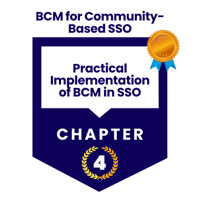Chapter 4
 Practical Implementation of BCM in Community-Based Social Service Organisations
Practical Implementation of BCM in Community-Based Social Service Organisations
However, the reality is that resilience can start small — with practical steps that make a real difference during disruptions.
This chapter explores how social service organisations can begin implementing BCM within their unique environments, focusing on what is achievable and sustainable, and, most importantly, centred on the well-being of the children, youth, and families they serve.
Starting Small and Scaling Up
One of the biggest misconceptions about BCM is that it must start as a significant, complex initiative. In truth, the best approach is to start small.
Begin by identifying one or two critical services — for example, residential care or therapy sessions — and develop simple continuity procedures around them. Once the process is familiar and tested, it can be expanded to cover other areas of operation.
Starting small allows staff to build confidence, understand the BCM process, and demonstrate success to management and donors. Over time, the organisation can scale up its efforts without feeling overwhelmed.
Involving Frontline Staff in Planning
Frontline staff are the heartbeat of any social service organisation. They understand the daily routines, challenges, and critical dependencies that keep programs running.
By involving them early in the planning process, organisations can ensure that BCM plans are realistic and grounded in operational realities. For example:
- Caregivers in residential homes can identify the practical steps needed to relocate children safely.
- Therapists can suggest how to maintain continuity of care during equipment or facility outages.
- Administrative staff can pinpoint which records and IT systems are vital for day-to-day operations.
This participatory approach not only improves the quality of planning but also creates ownership — staff become advocates for resilience rather than passive participants.
Balancing Limited Resources with BCM Needs
Many community organisations face the challenge of limited manpower and funding. Implementing BCM doesn’t require expensive software or external consultants. Instead, it’s about prioritising resources to protect what matters most.
Some low-cost strategies include:
- Developing clear, simple procedures instead of lengthy manuals.
- Using existing communication channels (e.g., WhatsApp groups) for emergency coordination.
- Cross-training staff so that essential functions can continue if key personnel are absent.
The focus should always be on maintaining continuity of care and safety within available means. Even modest planning efforts can significantly reduce confusion and stress during an actual disruption.
Collaborating with External Partners
No social service organisation operates in isolation. During crises, partnerships become lifelines.
Collaboration with external partners — such as government agencies, hospitals, vendors, volunteers, and donors — can help sustain operations when internal resources are stretched.
Examples include:
- Partnering with nearby schools, community centres, or faith-based organisations as temporary relocation sites.
- Coordinating with hospitals or healthcare providers to support children with special medical needs.
- Engaging vendors with backup supply arrangements for food, medication, or essential equipment.
- Leveraging volunteers and donor networks for logistics, transport, or communication support.
Strong partnerships built before a crisis make response and recovery smoother when disruptions occur.
Examples of Practical Continuity Measures
Here are several practical BCM measures that community-based organisations can adopt immediately:
Staff Cross-Training for Essential Functions
Train multiple staff members to perform key roles, including medication administration, meal preparation, and client intake. This ensures continuity when someone is unavailable.
Emergency Communication Trees
Establish clear communication lines for staff, volunteers, and families. Use contact lists, WhatsApp groups, or broadcast tools to share instructions during emergencies quickly.
Safe Evacuation and Relocation Plans
Develop and practice evacuation plans that prioritise child safety. Identify alternate housing or care facilities in advance for temporary relocation if a residential home becomes unsafe.
Remote or Virtual Therapy Sessions
During disruptions such as pandemics or facility closures, virtual therapy or telecounselling ensures clients continue to receive support. This was proven effective during COVID-19 and remains a best practice for maintaining care continuity.
Vendor Diversification for Supplies
Avoid reliance on a single supplier for critical items such as food, medication, or cleaning materials. Having multiple vendors reduces the risk of supply chain disruptions.
Building a Culture of Preparedness
Ultimately, the goal of BCM is not just to create documents, but to build a culture of preparedness. When staff at every level understand their role in keeping services running, resilience becomes part of the organisation’s DNA.
Leaders can reinforce this by:
- Regularly discussing BCM during staff meetings.
- Conducting short refresher drills.
- Recognising staff who contribute to crisis readiness.
Preparedness is not achieved overnight — it’s cultivated through consistent awareness, teamwork, and leadership commitment.
Conclusion: Resilience Begins with Simple Actions
Every community-based social service organisation can begin its BCM journey — regardless of size or resources.
By starting small, involving staff, using practical solutions, and collaborating with partners, organisations can build the capacity to respond effectively to crises while continuing to protect the children and youth in their care.
Resilience isn’t about perfection — it’s about preparation, compassion, and the commitment to continue serving, no matter the challenge.
More Information About Business Continuity Management Courses

 To learn more about the course and schedule, click the buttons below for the BCM-300 Business Continuity Management Implementer [B-3] course and the BCM-5000 Business Continuity Management Expert Implementer [B-5].
To learn more about the course and schedule, click the buttons below for the BCM-300 Business Continuity Management Implementer [B-3] course and the BCM-5000 Business Continuity Management Expert Implementer [B-5].
![Register [BL-B-3]*](https://no-cache.hubspot.com/cta/default/3893111/ac6cf073-4cdd-4541-91ed-889f731d5076.png) |
 |
 |
 |
 |
 |
![FAQ [BL-B-3]](https://no-cache.hubspot.com/cta/default/3893111/b3824ba1-7aa1-4eb6-bef8-94f57121c5ae.png) |
If you have any questions, click to contact us.
|
 |
 |
 |
 |





![[BCM] [SSO] [C1] BCM for Community-Based Social Services Organisations](https://no-cache.hubspot.com/cta/default/3893111/abcc60b1-a41a-47de-b0d5-84644744d776.png)
![[BCM] [SSO] [C2] Understanding BCM in Social Service Organisations](https://no-cache.hubspot.com/cta/default/3893111/8dbf8f0f-371f-437c-a7d7-ccaff00b9433.png)
![[BCM] [SSO] [C3] Building a Practical BCM Framework for Social Service Organisations](https://no-cache.hubspot.com/cta/default/3893111/879387df-1aee-4517-8d38-fa33138b82ab.png)
![[BCM] [SSO] [C5] Case Study – Fire in a Residential Care Facility](https://no-cache.hubspot.com/cta/default/3893111/f18526eb-1b38-42a2-9c7d-52afe2121435.png)
![[BCM] [SSO] [C6] Governance and Sustainability in BCM](https://no-cache.hubspot.com/cta/default/3893111/fc72acdb-d95e-4823-b7bf-27ce15cc7542.png)
![[BCM] [SSO] [C7] Conclusion – Building a Culture of Care and Continuity](https://no-cache.hubspot.com/cta/default/3893111/b5cd16e6-e11f-4b42-8349-e043bab8187e.png)
![Email to Sales Team [BCM Institute]](https://no-cache.hubspot.com/cta/default/3893111/3c53daeb-2836-4843-b0e0-645baee2ab9e.png)

